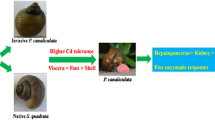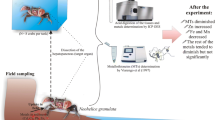Abstract
The talitrid amphipod crustacean Orchestia gammarellus (Pallas) was collected from metal-contaminated (Dulas Bay, Gironde) and control (Millport) sites in the UK and France. Irrespective of site of origin, the amphipods showed the same physiological mechanism of trace-metal detoxification, involving the ventral caeca. Copper was always present in lysosomal residual bodies in the ventral caeca. Following laboratory exposure to zinc and cadmium, the lysosomes usually contained both copper and zinc but cadmium was not detectable. The lysosomal copper concentration is positively correlated to that of sulphur, while the concentration of lysosomal zinc is related to that of phosphorus. Results are interpreted in terms of the differential rates of turnover of metallothioneins chelating copper, zinc or cadmium.
Similar content being viewed by others
Author information
Authors and Affiliations
Additional information
Received: 9 February 1999 / Accepted: 2 December 1999
Rights and permissions
About this article
Cite this article
Nassiri, Y., Rainbow, P., Amiard-Triquet, C. et al. Trace-metal detoxification in the ventral caeca of Orchestia gammarellus (Crustacea: Amphipoda). Marine Biology 136, 477–484 (2000). https://doi.org/10.1007/s002270050707
Issue Date:
DOI: https://doi.org/10.1007/s002270050707




